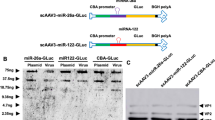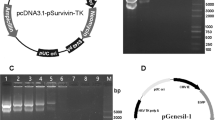Abstract
Replicating virus vectors are attractive tools for anticancer gene therapy, but the potential for adverse events due to uncontrolled spread of the vectors has been a major concern. To design a tumor-specific retroviral replicating vector (RRV), we replaced the U3 region of the RRV ACE-GFP with a regulatory sequence consisting of the hepatitis B virus enhancer II (EII) and human α-fetoprotein (AFP) core promoter to produce ACE-GFP-EIIAFP, a hepatocellular carcinoma (HCC)-targeting RRV. Similar to ACE-GFP, ACE-GFP-EIIAFP exhibited robust green fluorescent protein (GFP) expression in HCC cells and, most importantly, it exhibited HCC-specific replication and did not replicate in non-HCC tumor cells or normal liver cells. We sequenced the promoter region of ACE-GFP-EIIAFP collected from serial infection cycles to examine the genomic stability of the vector during its replicative spread, and found that the vector could retain the hybrid promoter in the genome for at least six infection cycles. In vitro studies revealed that ACE-CD-EIIAFP and ACE-PNP-EIIAFP, which express the yeast cytosine deaminase and Escherichia coli purine nucleoside phosphorylase, respectively, exert a highly potent cytotoxic effect on HCC cells in the presence of their respective prodrugs. In vivo, ACE-CD-EIIAFP-mediated suicide gene therapy efficiently suppressed HCC tumor growth and no detectable RRV signal was observed in extratumoral tissues. These results suggest that the tumor-specific, suicide-gene-encoding RRV may fulfill the promise of retroviral gene therapy for cancer.
This is a preview of subscription content, access via your institution
Access options
Subscribe to this journal
Receive 12 print issues and online access
$259.00 per year
only $21.58 per issue
Buy this article
- Purchase on Springer Link
- Instant access to full article PDF
Prices may be subject to local taxes which are calculated during checkout






Similar content being viewed by others
References
Ram Z, Culver KW, Walbridge S, Frank JA, Blaese RM, Oldfield EH . Toxicity studies of retroviral-mediated gene transfer for the treatment of brain tumors. J Neurosurg 1993; 79: 400–407.
Hein A, Czub S, Xiao LX, Schwender S, Dorries R, Czub M . Effects of adoptive immune transfers on murine leukemia virus-infection of rats. Virology 1995; 211: 408–417.
Traister RS, Lynch WP . Reexamination of amphotropic murine leukemia virus neurovirulence: neural stem cell-mediated microglial infection fails to induce acute neurodegeneration. Virology 2002; 293: 262–272.
Culver KW, Ram Z, Wallbridge S, Ishii H, Oldfield EH, Blaese RM . In vivo gene transfer with retroviral vector-producer cells for treatment of experimental brain tumors. Science 1992; 256: 1550–1552.
Miller DG, Adam MA, Miller AD . Gene transfer by retrovirus vectors occurs only in cells that are actively replicating at the time of infection. Mol Cell Biol 1990; 10: 4239–4242.
Varmus HE, Padgett T, Heasley S, Simon G, Bishop JM . Cellular functions are required for the synthesis and integration of avian sarcoma virus-specific DNA. Cell 1977; 11: 307–319.
Thomas CE, Ehrhardt A, Kay MA . Progress and problems with the use of viral vectors for gene therapy. Nat Rev Genet 2003; 4: 346–358.
Rainov NG . A phase III clinical evaluation of herpes simplex virus type 1 thymidine kinase and ganciclovir gene therapy as an adjuvant to surgical resection and radiation in adults with previously untreated glioblastoma multiforme. Hum Gene Ther 2000; 11: 2389–2401.
Harsh GR, Deisboeck TS, Louis DN, Hilton J, Colvin M, Silver JS et al. Thymidine kinase activation of ganciclovir in recurrent malignant gliomas: a gene-marking and neuropathological study. J Neurosurg 2000; 92: 804–811.
Kruse CA, Roper MD, Kleinschmidt-DeMasters BK, Banuelos SJ, Smiley WR, Robbins JM et al. Purified herpes simplex thymidine kinase Retrovector particles. I. In vitro characterization, in situ transduction efficiency, and histopathological analyses of gene therapy-treated brain tumors. Cancer Gene Ther 1997; 4: 118–128.
Puumalainen AM, Vapalahti M, Agrawal RS, Kossila M, Laukkanen J, Lehtolainen P et al. Beta-galactosidase gene transfer to human malignant glioma in vivo using replication-deficient retroviruses and adenoviruses. Hum Gene Ther 1998; 9: 1769–1774.
Ram Z, Culver KW, Oshiro EM, Viola JJ, DeVroom HL, Otto E et al. Therapy of malignant brain tumors by intratumoral implantation of retroviral vector-producing cells. Nat Med 1997; 3: 1354–1361.
Smiley WR, Laubert B, Howard BD, Ibanez C, Fong TC, Summers WS et al. Establishment of parameters for optimal transduction efficiency and antitumor effects with purified high-titer HSV-TK retroviral vector in established solid tumors. Hum Gene Ther 1997; 8: 965–977.
Logg CR, Logg A, Tai CK, Cannon PM, Kasahara N . Genomic stability of murine leukemia viruses containing insertions at the Env-3' untranslated region boundary. J Virol 2001; 75: 6989–6998.
Tai CK, Logg CR, Park JM, Anderson WF, Press MF, Kasahara N . Antibody-mediated targeting of replication-competent retroviral vectors. Hum Gene Ther 2003; 14: 789–802.
Tai CK, Wang W, Lai YH, Logg CR, Parker WB, Li YF et al. Enhanced efficiency of prodrug activation therapy by tumor-selective replicating retrovirus vectors armed with the Escherichia coli purine nucleoside phosphorylase gene. Cancer Gene Ther 2010; 17: 614–623.
Lu YC, Luo YP, Wang YW, Tai CK . Highly efficient gene transfer to solid tumors in vivo by tumor-selective replicating retrovirus vectors. Int J Mol Med 2010; 25: 769–775.
Logg CR, Tai CK, Logg A, Anderson WF, Kasahara N . A uniquely stable replication-competent retrovirus vector achieves efficient gene delivery in vitro and in solid tumors. Hum Gene Ther 2001; 12: 921–932.
Wang WJ, Tai CK, Kasahara N, Chen TC . Highly efficient and tumor-restricted gene transfer to malignant gliomas by replication-competent retroviral vectors. Hum Gene Ther 2003; 14: 117–127.
Tai CK, Wang WJ, Chen TC, Kasahara N . Single-shot, multicycle suicide gene therapy by replication-competent retrovirus vectors achieves long-term survival benefit in experimental glioma. Mol Ther 2005; 12: 842–851.
Diaz RM, Eisen T, Hart IR, Vile RG . Exchange of viral promoter/enhancer elements with heterologous regulatory sequences generates targeted hybrid long terminal repeat vectors for gene therapy of melanoma. J Virol 1998; 72: 789–795.
Ferrari G, Salvatori G, Rossi C, Cossu G, Mavilio F . A retroviral vector containing a muscle-specific enhancer drives gene expression only in differentiated muscle fibers. Hum Gene Ther 1995; 6: 733–742.
Moore KA, Scarpa M, Kooyer S, Utter A, Caskey CT, Belmont JW . Evaluation of lymphoid-specific enhancer addition or substitution in a basic retrovirus vector. Hum Gene Ther 1991; 2: 307–315.
Logg CR, Logg A, Matusik RJ, Bochner BH, Kasahara N . Tissue-specific transcriptional targeting of a replication-competent retroviral vector. J Virol 2002; 76: 12783–12791.
Ido A, Nakata K, Kato Y, Nakao K, Murata K, Fujita M et al. Gene therapy for hepatoma cells using a retrovirus vector carrying herpes simplex virus thymidine kinase gene under the control of human alpha-fetoprotein gene promoter. Cancer Res 1995; 55: 3105–3109.
Mawatari F, Tsuruta S, Ido A, Ueki T, Nakao K, Kato Y et al. Retrovirus-mediated gene therapy for hepatocellular carcinoma: selective and enhanced suicide gene expression regulated by human alpha-fetoprotein enhancer directly linked to its promoter. Cancer Gene Ther 1998; 5: 301–306.
Nakabayashi H, Koyama Y, Suzuki H, Li HM, Sakai M, Miura Y et al. Functional mapping of tissue-specific elements of the human alpha-fetoprotein gene enhancer. Biochem Biophys Res Commun 2004; 318: 773–785.
Kramer MG, Barajas M, Razquin N, Berraondo P, Rodrigo M, Wu C et al. In vitro and in vivo comparative study of chimeric liver-specific promoters. Mol Ther 2003; 7: 375–385.
Kievit E, Bershad E, Ng E, Sethna P, Dev I, Lawrence TS et al. Superiority of yeast over bacterial cytosine deaminase for enzyme/prodrug gene therapy in colon cancer xenografts. Cancer Res 1999; 59: 1417–1421.
Hong JS, Waud WR, Levasseur DN, Townes TM, Wen H, McPherson SA et al. Excellent in vivo bystander activity of fludarabine phosphate against human glioma xenografts that express the escherichia coli purine nucleoside phosphorylase gene. Cancer Res 2004; 64: 6610–6615.
Sorscher EJ, Peng S, Bebok Z, Allan PW, Bennett Jr LL, Parker WB . Tumor cell bystander killing in colonic carcinoma utilizing the Escherichia coli DeoD gene to generate toxic purines. Gene Therapy 1994; 1: 233–238.
Hiraoka K, Kimura T, Logg CR, Tai CK, Haga K, Lawson GW et al. Therapeutic efficacy of replication-competent retrovirus vector-mediated suicide gene therapy in a multifocal colorectal cancer metastasis model. Cancer Res 2007; 67: 5345–5353.
Tai CK, Kasahara N . Replication-competent retrovirus vectors for cancer gene therapy. Front Biosci 2008; 13: 3083–3095.
Duerner LJ, Schwantes A, Schneider IC, Cichutek K, Buchholz CJ . Cell entry targeting restricts biodistribution of replication-competent retroviruses to tumour tissue. Gene Therapy 2008; 15: 1500–1510.
Lin AH, Timberlake N, Logg CR, Liu Y, Kamijima S, Diago O et al. MicroRNA 142-3p attenuates spread of replicating retroviral vector in hematopoietic lineage-derived cells while maintaining an antiviral immune response. Hum Gene Ther 2014; 25: 759–771.
Metzl C, Mischek D, Salmons B, Gunzburg WH, Renner M, Portsmouth D . Tissue- and tumor-specific targeting of murine leukemia virus-based replication-competent retroviral vectors. J Virol 2006; 80: 7070–7078.
Nakamura H, Mullen JT, Chandrasekhar S, Pawlik TM, Yoon SS, Tanabe KK . Multimodality therapy with a replication-conditional herpes simplex virus 1 mutant that expresses yeast cytosine deaminase for intratumoral conversion of 5-fluorocytosine to 5-fluorouracil. Cancer Res 2001; 61: 5447–5452.
Parker WB, Allan PW, Shaddix SC, Rose LM, Speegle HF, Gillespie GY et al. Metabolism and metabolic actions of 6-methylpurine and 2-fluoroadenine in human cells. Biochem Pharmacol 1998; 55: 1673–1681.
Huber BE, Austin EA, Richards CA, Davis ST, Good SS . Metabolism of 5-fluorocytosine to 5-fluorouracil in human colorectal tumor cells transduced with the cytosine deaminase gene: significant antitumor effects when only a small percentage of tumor cells express cytosine deaminase. Proc Natl Acad Sci USA 1994; 91: 8302–8306.
Lu YC, Chen YJ, Yu YR, Lai YH, Cheng JC, Li YF et al. Replicating retroviral vectors for oncolytic virotherapy of experimental hepatocellular carcinoma. Oncol Rep 2012; 28: 21–26.
Hersh MR, Kuhn JG, Phillips JL, Clark G, Ludden TM, Von Hoff DD . Pharmacokinetic study of fludarabine phosphate (NSC 312887). Cancer Chemother Pharmacol 1986; 17: 277–280.
Malspeis L, Grever MR, Staubus AE, Young D . Pharmacokinetics of 2-F-ara-A (9-beta-D-arabinofuranosyl-2-fluoroadenine) in cancer patients during the phase I clinical investigation of fludarabine phosphate. Semin Oncol 1990; 17 (5 Suppl 8): 18–32.
Danhauser L, Plunkett W, Keating M, Cabanillas F . 9-beta-D-arabinofuranosyl-2-fluoroadenine 5'-monophosphate pharmacokinetics in plasma and tumor cells of patients with relapsed leukemia and lymphoma. Cancer Chemother Pharmacol 1986; 18: 145–152.
Danhauser L, Plunkett W, Liliemark J, Gandhi V, Iacoboni S, Keating M . Comparison between the plasma and intracellular pharmacology of 1-beta-D-arabinofuranosylcytosine and 9-beta-D-arabinofuranosyl-2-fluoroadenine 5'-monophosphate in patients with relapsed leukemia. Leukemia 1987; 1: 638–643.
DuBridge RB, Tang P, Hsia HC, Leong PM, Miller JH, Calos MP . Analysis of mutation in human cells by using an Epstein-Barr virus shuttle system. Mol Cell Biol 1987; 7: 379–387.
Acknowledgements
We thank Dr Noriyuki Kasahara for many helpful suggestions and discussion. We thank Chi Tsung Li for assistance with ELISA to detect AFP. This work was supported by a grant from the National Science Council of Taiwan (NSC99-2320-B-194-004-MY3).
Author information
Authors and Affiliations
Corresponding author
Ethics declarations
Competing interests
The authors declare no conflict of interest.
Additional information
Supplementary Information accompanies this paper on Gene Therapy website
Supplementary information
Rights and permissions
About this article
Cite this article
Lai, YH., Lin, CC., Chen, SH. et al. Tumor-specific suicide gene therapy for hepatocellular carcinoma by transcriptionally targeted retroviral replicating vectors. Gene Ther 22, 155–162 (2015). https://doi.org/10.1038/gt.2014.98
Received:
Revised:
Accepted:
Published:
Issue Date:
DOI: https://doi.org/10.1038/gt.2014.98
This article is cited by
-
Evaluation of the Glypican 3 promoter for transcriptional targeting of hepatocellular carcinoma
Gene Therapy (2018)
-
Dendrimer-based nanoparticles in cancer chemotherapy and gene therapy
Science China Materials (2018)
-
Management strategies for hepatocellular carcinoma: old certainties and new realities
Clinical and Experimental Medicine (2016)



